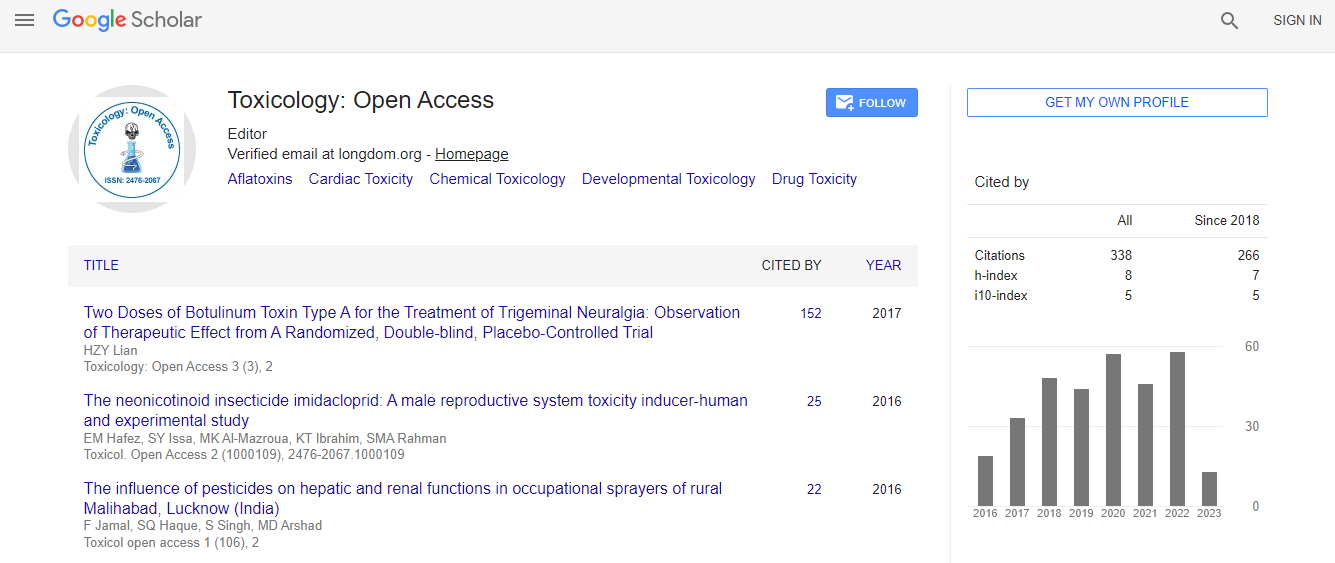Our Group organises 3000+ Global Conferenceseries Events every year across USA, Europe & Asia with support from 1000 more scientific Societies and Publishes 700+ Open Access Journals which contains over 50000 eminent personalities, reputed scientists as editorial board members.
Open Access Journals gaining more Readers and Citations
700 Journals and 15,000,000 Readers Each Journal is getting 25,000+ Readers
Google Scholar citation report
Citations : 336
Toxicology: Open Access received 336 citations as per Google Scholar report
Indexed In
- Google Scholar
- RefSeek
- Hamdard University
- EBSCO A-Z
- Geneva Foundation for Medical Education and Research
- Euro Pub
- ICMJE
Useful Links
Related Subjects
Share This Page
Rate of interaction between antibiotics and nonsteroidal anti-inflammatory drugs in a district hospital in Palestine
8th World Congress on Toxicology and Pharmacology
Yasin I Tayem, Murad I Ibrahim, Marwan M Qubaja, Omar B Taha, Emad A Schedem and Riyad K Shraim
Arabian Gulf University, Bahrain Al Quds University, Palestine Beit Jala Hospital, Palestine
ScientificTracks Abstracts: Toxicol Open Access
Abstract
Objectives: Nonsteroidal anti-inflammatory drugs (NSAIDs) and antibiotics (ATBs) are commonly prescribed together. We aimed to describe the rate of interaction between these two drug groups in ambulatory prescriptions made at a district hospital in Palestine. Methods: In this retrospective, cross-sectional study, we analyzed a random sample of outpatient prescriptions ordered over one year by the outpatient clinics and emergency room in Beit Jala Hospiatal, Bethlehem, Palestine. The orders which contained a combination of NSAIDs and ATBs were analyzed for the rate and significance of drug interactions between these two drug groups. Results: Out of 2208 prescriptions screened, 91 orders contained a combination of NSAIDs and ATBs (4.1%) and were included in the study. Within the included prescriptions, 45 orders harbored potential drug interactions between the two drug groups (49.5%). Regarding the significance of these interactions, none of them was serious. However, 21 orders were rated to have significant interactions (46.7%) while 24 prescriptions had non-significant interactions (53.3%). The most common ATB which was found to cause significant interaction was ciprofloxacin (100%). On the other hand, aspirin was the most important NSAID to cause significant interaction (42.8 %) followed by diclofenac (38.1%). Conclusions: Our data revealed a remarkably high rate of drug interactions between ATBs and NSAIDs. To minimize the potential harm as a result of this interaction, prescribers� awareness of the importance of careful drug selection needs to be reinforced. This should ideally include providing training for physicians on the use of free online drug interaction checkers.Biography
Yasin I Tayem received his MD from Al-Quds University School of Medicine, Palestine in 2001 and PhD in Clinical Sciences from the University of London, United Kingdom in 2006. He was an Assistant Professor of Pharmacology at the Al-Quds University from 2006 until 2012. Then he was a Post-doctoral research fellow at the National Institutes of Health (NIH), Maryland, USA. Since, 2013 he has been an Assistant Professor of Pharmacology and Therapeutics at the Arabian Gulf University in Bahrain. He has published more than 17 articles. His research focuses on drug interactions, pharmacology education and language barrier in medical education in the Arab World.
Email: yasin.tayem@gmail.com

 Spanish
Spanish  Chinese
Chinese  Russian
Russian  German
German  French
French  Japanese
Japanese  Portuguese
Portuguese  Hindi
Hindi 